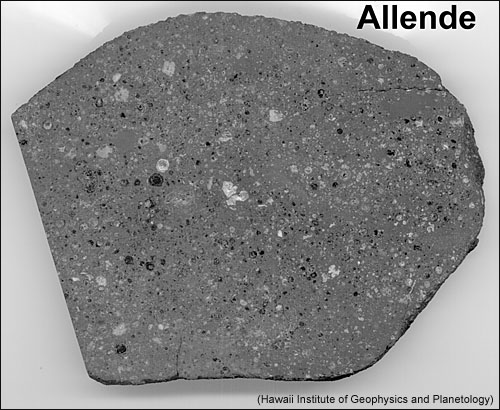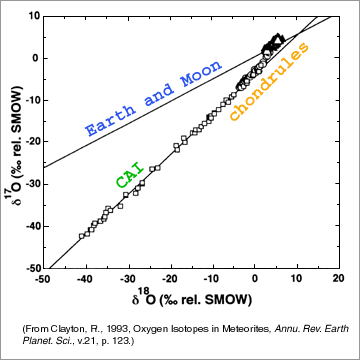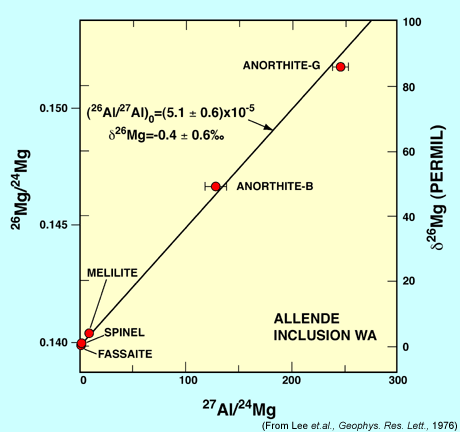|
|
|
|
|
|
|
Making Sense of Droplets Inside Droplets--- The vexing presence of chondrules inside supposedly older calcium-aluminum-rich inclusions (CAIs) in chondrites makes sense if the CAIs were remelted.
Written by G. Jeffrey Taylor |
 |
Alexander (Sasha) Krot (University of Hawaii), Professor Yurimoto from Tokyo, Ian Hutcheon (Lawrence Livermore National Laboratory), and Glenn MacPherson (Smithsonian Institution) report two additional cases of chondrules inside CAIs. They show that in both cases the CAIs contained less 26Al when they crystallized than did most CAIs. The CAIs are also depleted in oxygen-16 (16O), a characteristic associated with chondrules. Durable minerals located in the central parts of the two CAIs have 16O-rich compositions. Krot and his co-workers conclude that the two chondrule-bearing CAIs had chondrule material added to them during a reheating event about 2 million years after they had originally formed. The conventional wisdom that CAIs are older than chondrules remains intact, at least for now, but this work shows that CAIs, like most solar system materials, can be reworked after they form.
Reference:
Chondrules and CAIs: Hot Stuff in the Early Solar System
Chondritic meteorites are composed of materials that formed before planets roamed the solar system. The oldest of these materials are calcium-aluminum-rich inclusions (CAIs), light-colored objects rich in refractory elements (that condense at a high temperature). Besides calcium and aluminum, this includes magnesium, titanium, and rare earth elements. CAIs range in size from about a millimeter to a centimeter. Meteoriticists have identified several distinct varieties of CAIs, but all share a high temperature origin. Some might be condensates from the solar nebula; for example, see the PSRD article: First Rock in the Solar System. Other CAIs might be evaporation residues.
 |
| Slab of the Allende CV carbonaceous chondrite [Data link from Meteoritical Database]. Large light-colored objects are CAIs. Smaller, round, dark objects are chondrules. |
 |
| A calcium-aluminum-rich inclusion (CAI) in the carbonacious chondrite Efremovka with anorthite (an), melilite (mel), and pyroxene (px) [Data link from Meteoritical Database]. |
Chondrules are millimeter-sized frozen droplets of molten silicate. They are less refractory than CAIs, but are still relatively high-temperature products of solar system formation. Like CAIs, they come in a wide variety of types, but all share a history of having been melted (requires a temperature of more than 1400oC) and cooled rapidly (5 to 1000oC/hour).
 |
| The chondritic meteorite PCA 91082 contains both chondrules and CAIs [Data link from Meteoritical Database]. This X-ray map shows the elemental abundances in the meteorite: red is magnesium, green is calcium and blue is aluminum. |
Oxygen Isotope Fingerprint
The relative abundances of the isotopes of oxygen are very informative about the origin of solar system materials. There are three stable (non-radioactive) varieties of oxygen isotopes. Each has the same number of protons in the nucleus, but different numbers of neutrons, resulting in atomic masses of 16, 17, and 18. These different isotopes are called oxygen-16 (16O), oxygen-17 (17O), and oxygen-18 (18O).
On Earth, rocks vary in the proportions of the three oxygen isotopes, but they vary in a simple way. Two rocks with the same 18O/16O ratio will have the same 17O/16O ratio. If their 18O/16O ratios differ by, say, 0.2%, their 17O/16O ratios will differ by half this amount, 0.1%. Rocks from Mars and igneous (melted) meteorites (which come from asteroids) follow the same pattern, though the lines are offset from the Earth line. Moon rocks lie on the Earth line. Thus, on a plot of 17O/16O vs 18O/16O, planetary rock data lie along a line with a slope of 0.5.
CAIs and chondrules do not obey this well established planetary slope 0.5 behavior. They plot along a slope 1 line. Change 18O/16O by 0.1% and 17O/16O also changes by 0.1%. This is consistent with addition or loss of pure 16O. There are several proposed sources for the 16O [see PSRD article: Oxygen Isotopes Give Clues to the Formation of Planets, Moons, and Asteroids] but let's just use the amount of 16O as a marker. In general, CAIs have a higher abundance of 16O than do chondrules, as shown in the diagram below.
 |
| Plot showing the 18O/16O and 17O/16O ratios in chondrules and CAIs in meteorites. These particles define a line with much steeper slope than the Earth line, consistent with loss or addition of 16O. Chondrules contain less 16O than do CAIs. Cosmochemists measure the 18O/16O and 17O/16O ratios in terms of deviations in parts per thousand from a standard (delta 18O and delta 17O). The usual standard is mean ocean water, abbreviated SMOW, for Standard Mean Ocean Water. Pure 16O would plot at -1000 parts per thousand on both axes. |
Ages from Vanished Isotopes
Cosmochemists can determine the relative ages of objects formed more than 4.5 billion years ago by using the abundances of the decay products of isotopes that no longer exist. The isotopes vanished because their half-lives were so short that they have completely decayed. A prime example of this is 26Al, which has a half life of only 730,000 years. It decays to magnesium-26 (26Mg). The trick, of course, is to figure out how to measure the abundance of something that no longer exists. Cosmochemists perform this feat of isotopic magic by measuring the aluminum and magnesium isotopes in different minerals in the same samples. If 26Al was present when a sample formed, as the concentration of aluminum increases, so should the abundance of 26Mg relative to 24Mg. An example of this technique is shown in the diagram below. For more information, see PSRD article: Using Aluminum-26 as a Clock for Early Solar System Events.
 |
| Magnesium isotopic ratios measured in different minerals with different ratios of aluminum to magnesium from a refractory inclusion in the meteorite Allende. Magnesium shows excesses in the isotope 26 that are correlated with the aluminum/magnesium ratio, indicating that the 26Mg excesses originated from the decay of the radioactive isotope 26Al. This finding is evidence for the initial presence of 26Al in early solar system objects. |
Almost all the data gathered up to now indicate that the initial ratio of 26Al/27Al is higher in CAIs than in chondrules. This ratio varied with time in the early solar system because 26Al is radioactive. Data for CAIs uniformly give an initial 26Al/27Al ratio of 5 x 10-5. Every half life (730,000 years) decreases 26Al/27Al by a factor of two. Chondrules tend to have 26Al/27Al lower than the values in CAIs. Using the half life of 26Al, the 26Al/27Al ratio, and the equation for radioactive decay, cosmochemists calculate that chondrules are between 1 and 3 million years younger than CAIs.
The story is not completely clear cut, of course. Martin Bizzarro and colleagues at the Geological Museum, Denmark, and Victoria University of Wellington, New Zealand, made very accurate isotopic analyses of chondrules and CAIs drilled out of polished slabs of the Allende chondrite. The five CAIs analyzed fell on a single line that indicated the usual value of 5 x 10-5 for the 26Al/27Al ratio. The chondrules, however, scattered more, indicating a range of initial 26Al/27Al ratios. Some were equal to the typical CAI value; others were lower. Taken together Martin Bizzarro's data suggest that formation of chondrules and CAIs began at the same time, but that chondrule formation continued for 1-2 million years after production of CAIs stopped. However, Sasha Krot and his colleagues argue that Bizzarro dated the formation of the chondrule precursor dust, not the time chondrules formed by melting. Dating the time of formation of individual chondrules cannot be done unambiguously from a bulk isotopic analysis of a chondrule--magnesium and aluminum isotopes must be measured on separate mineral grains in a chondrule.
Nevertheless, Martin Bizzarro and his colleagues raise an important issue that must be settled. One important line of evidence is the presence of CAIs inside chondrules. These have been observed by several meteoriticists, including Sasha Krot and Hisayoshi Yurimoto and their co-workers. To be incorporated into a molten chondrule, a CAI must already exist, hence is older. All the cases reported were of CAIs inside chondrules. All, that is, until Itoh and Yurimoto found a chondrule inside a CAI, implying contemporaneous formation of chondrules and CAIs, in accord with the interpretation Martin Bizzarro and his colleagues made from their isotopic data.
Chondrules Inside CAIs
Sasha Krot was intrigued by the unsettling data reported by Bizzarro and co-workers and by Itoh and Yurimoto. The data appeared to upset a perfectly good applecart. He applied his very astute eye to some chondrites and found more cases of chondrules inside CAIs. Then, working with Hisayoshi Yurimoto, Ian Hutcheon, and Glenn MacPherson, they studied the chondrules in detail with electron microscopy and electron and ion microanalysis, and analyzed oxygen, magnesium, and aluminum isotopes. The evidence they assembled suggests that the CAIs containing chondrules were remelted in the chondrule-forming region.
 |
| The top picture is of a CAI (blue and green) in the Allende meteorite. The image was made by combining x-ray counts from magnesium (red), calcium (green), and aluminum (blue) in an electron microprobe. The area in the square labeled c is shown in an electron microscope image in the lower photograph. The minerals olivine (ol) and orthopyroxene (opx) are common in chondrules. Compositions and the minerals present point to this area being a little piece of a chondrule. It was included in the CAI melt, so must have existed already--that is, it is older. |
Krot and co-workers describe two CAIs that contain chondrule fragments. The photographs above show what one of them looks like if your eyes could see electrons and x-rays. The chondrules are clearly identified by the presence of iron-bearing olivine and orthopyroxene, common minerals in chondrules but not in CAIs.
As shown in the oxygen isotope diagram above, CAIs and chondrules have different amounts of 16O. Krot and his colleagues reasoned that if the CAIs were remelted and had chondrules added to them, this ought to show up in the oxygen isotopic compositions of mineral grains in the CAIs and in their included chondrules. This is exactly what they found. Using an ion microprobe they measured the isotopic compositions of minerals in each CAI and its chondrule chip. They found that the chondrule material had the normal chondrule oxygen, which is low in 16O. Relict, hard-to-melt grains like spinel had more typical CAI-like compositions much richer in 16O. Minerals that occur in the outer zones of the CAIs have low amounts of 16O. All this suggests that both CAIs could have been remelted, and a pre-existing chondrule was added to the melt.
 |
| Oxygen isotopic compositions of minerals in two CAIs that contain chondrule fragments. The minerals in the chondrules and in the outer portions of the CAI have relatively low amounts of 16O (they plot close to the intersection with the terrestrial line). Minerals in the interior and minerals that melt at high temperatures (e.g., spinel) preserve the typical composition richer in 16O. |
Krot and co-workers also measured magnesium and aluminum isotopes in individual minerals using an ion microprobe. They found that when the latest melting took place the chondrules contained much less 26Al than typical for CAIs. This could mean that the CAIs formed later than other CAIs. Or, it might mean that the CAIs formed at one time and were then remelted some time later. According to the 26Al abundance, this second melting would have taken place about 2 million years after the CAIs with the initial 26Al/27Al ratio (5 x 10-5) formed (see diagram below). Krot favors the second explanation on the basis of typical 16O abundance in minerals in the interiors of the CAIs.
 |
| Magnesium isotope abundances measured in different minerals with different aluminum to magnesium ratios in two chondrule-bearing CAIs (labeled ABC and TS26). The slopes of the lines fitted to the data for these two inclusions are more than ten times less than the 5 x 10-5 value characteristic of most CAIs, suggesting the two chondrule-bearing inclusions formed at least 2 million years later. Sasha Krot and his colleagues suggest that the younger age for these CAIs was caused by a heating event that remelted them and incorporated chondrule materials inside the molten glob of CAI. |
Looking Back in Time
This trip in a time machine to events that took place before the planets formed would not be possible without high-tech analytical tools. The CAIs and their included chondrules were identified by optical microscopy and characterized by scanning electron microscopy and electron microprobe analysis. The isotopic compositions of oxygen, magnesium, and aluminum were measured with an ion microprobe, an amazing device that can measure isotopes and trace elements on the scale of less than a millimeter. These tools and the experience and intuitive powers of the cosmochemists involved allow us to look back in time to when gas and dust surrounded the young Sun, but before the planets accreted out of the dusty cloud. In fact, the melting events recorded by the CAIs that Krot and his team describe may be part of the planet-forming process.
|
|
[ About PSRD |
Archive |
Search |
Subscribe ] [ Glossary | General Resources | Comments | Top of page ] |